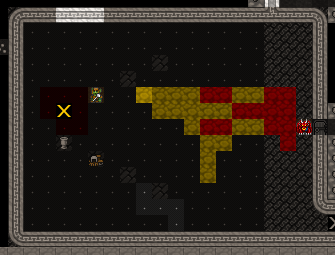- v50 information can now be added to pages in the main namespace. v0.47 information can still be found in the DF2014 namespace. See here for more details on the new versioning policy.
- Use this page to report any issues related to the migration.
Difference between revisions of "Dragonfire"
(+bug, +slade) |
(Dragonfire now affects metals) |
||
| Line 5: | Line 5: | ||
'''Dragonfire''' is a very powerful form of [[fire]] that is produced by [[dragon]]s. Dragonfire forms a rough cone shape, with a range of approximately 20 tiles and a spread of 10 tiles{{cite talk|DF2012:fire#Dragonfire}}. Notably, dragonfire does not spread vertically through additional [[z-level]]s (although dragons will target visible creatures on other z-levels). Despite its powerfully destructive nature, dragonfire can effectively be blocked by a simple [[shield]] better than 99% of the time. | '''Dragonfire''' is a very powerful form of [[fire]] that is produced by [[dragon]]s. Dragonfire forms a rough cone shape, with a range of approximately 20 tiles and a spread of 10 tiles{{cite talk|DF2012:fire#Dragonfire}}. Notably, dragonfire does not spread vertically through additional [[z-level]]s (although dragons will target visible creatures on other z-levels). Despite its powerfully destructive nature, dragonfire can effectively be blocked by a simple [[shield]] better than 99% of the time. | ||
| − | Legends claim that dragonfire can reach temperatures up to {{ct|50000}}. At that temperature, almost all materials should be destroyed (the [[dragon]]'s own body and its butchering products are exceptions). However, research has shown that dragonfire is quite particular about which objects it affects. When in a tile with dragonfire, organic materials will ignite, even including [[nether-cap]] wood with its fixed temperature. Non-flammable common [[stone]], [[glass]], and [[ceramic]] items will melt and boil away. | + | Legends claim that dragonfire can reach temperatures up to {{ct|50000}}. At that temperature, almost all materials should be destroyed (the [[dragon]]'s own body and its butchering products are exceptions). However, research has shown that dragonfire is quite particular about which objects it affects. When in a tile with dragonfire, organic materials will ignite, even including [[nether-cap]] wood with its fixed temperature. Non-flammable common [[stone]], [[glass]], and [[ceramic]] items will melt and boil away. Prior to v0.43.03, metal objects and metal buildings were immune to dragonfire, even non-fire-safe metals like [[tin]].{{bug|6517}} Dragonfire is similarly ineffective against [[water]], producing no [[steam]] or evaporation. [[Building]]s (but not [[construction]]s) are affected by dragonfire on their tile, making non-dragonfire-safe doors immune as long as they remain closed. Objects and buildings (and creatures) made out of [[slade]] are also immune to dragonfire since the raws do not define a specific heat for slade. |
Objects ignited by dragonfire drop to and continue to burn at their standard combustion temperature, however repeated blasts of dragonfire can sustain much higher combustion temperatures, sufficient even to eventually melt nearby [[adamantine]]. | Objects ignited by dragonfire drop to and continue to burn at their standard combustion temperature, however repeated blasts of dragonfire can sustain much higher combustion temperatures, sufficient even to eventually melt nearby [[adamantine]]. | ||
Revision as of 14:39, 21 May 2016
v52.04 · v0.47.05 This article is about the current version of DF.Note that some content may still need to be updated. |

Dragonfire is a very powerful form of fire that is produced by dragons. Dragonfire forms a rough cone shape, with a range of approximately 20 tiles and a spread of 10 tiles[1]. Notably, dragonfire does not spread vertically through additional z-levels (although dragons will target visible creatures on other z-levels). Despite its powerfully destructive nature, dragonfire can effectively be blocked by a simple shield better than 99% of the time.
Legends claim that dragonfire can reach temperatures up to 50000 °U . At that temperature, almost all materials should be destroyed (the dragon's own body and its butchering products are exceptions). However, research has shown that dragonfire is quite particular about which objects it affects. When in a tile with dragonfire, organic materials will ignite, even including nether-cap wood with its fixed temperature. Non-flammable common stone, glass, and ceramic items will melt and boil away. Prior to v0.43.03, metal objects and metal buildings were immune to dragonfire, even non-fire-safe metals like tin.Bug:6517 Dragonfire is similarly ineffective against water, producing no steam or evaporation. Buildings (but not constructions) are affected by dragonfire on their tile, making non-dragonfire-safe doors immune as long as they remain closed. Objects and buildings (and creatures) made out of slade are also immune to dragonfire since the raws do not define a specific heat for slade.
Objects ignited by dragonfire drop to and continue to burn at their standard combustion temperature, however repeated blasts of dragonfire can sustain much higher combustion temperatures, sufficient even to eventually melt nearby adamantine.